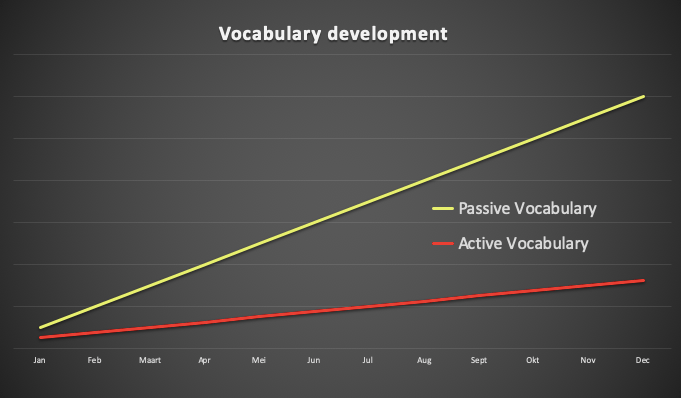What is the difference between Passive and Active vocabulary?
Passive Vocabulary = a summary of all words you understand but do not use in your speaking. You understand a lot but you cannot reply.
Active Vocabulary = a summary of all words you understand and use in your speaking. You understand a lot and you can reply.
Passive Vocabulary = understanding
Active Vocabulary = speaking
Usually we develop our Passive vocabulary first and our Active vocabulary lags behind. It takes a while before we are ready to start speaking.
The main goal of our Dutch course is trying to develop your Passive and Active vocabulary at the same time, almost parallel next to each other:
But how can we achieve this? Let’s dive into the nature of Active vocabulary.
What is the nature of Active vocabulary?
Every word has 2 things; an image (it’s written, you can read it) and sound (pronunciation and speech recognition).
You need to build in your mind:
- your database of images
- your database of speech recognition
- your database of pronunciation
Database of images = a library of word templates (how do words look like)
Database of speech recognition = a library of sound templates (how do words sound like)
Database of pronunciation = a library of pronunciation templates (how you pronounce words)
How do you build your database of images?
In order to build a library of images you need to watch movies with Dutch subtitles. Do not learn all words. Enjoy your movie. Relax your mind and let it watch subtitles instead of reading them.
Watch them like you would watch clouds in the sky. Do not read them. Just let them flow. If you see one word very often (like 3 times in 10 min) it means that it is a frequently used word in the spoken language. Write it down on a post-it and keep watching. When the movie is finished, put the translation of words on the flip side. Put your post-its on your mirror, computer, fridge, doors, walls etc. Play a post-its game (try to guess the translation during the day). Please review your post-its every morning when you wake up and every evening before you are going to bed. The repetition at the different times of the day is the key of learning. Why? Because your short memory works best in the morning and the long in the evening. We will explain it in our Dutch lessons. Movies are a great source of everyday speaking vocabulary.
Some people like to listen to Dutch music and read lyrics along. This is also a good way to learn new words. You can also watch cartoons with subtitles. Another way to memorize new words is to put them in your Google agenda. Create a recurring appointment (event) for every day on your Google agenda and put your new words there. Make sure you switch a notification on. You will be notified with your new vocabulary every day. When you know these words, you can replace them with new words by editing your appointment (event) on Google agenda.
How do you build your database of speech recognition?
In order to build a library of speech recognition you need to listen to BNR radio in a passive way. No need to pay any attention to it. Just switch it on and let it be your background ‘noise’. Your unconscious mind will listen to it even you are not paying any attention. You need to develop a Dutch language melody. It is a kind of melody which every song has. The Dutch language melody is important for speech recognition and building sentences or questions on the fly during conversations.
How do you build your library of pronunciation?
The library of pronunciation is a library of sound templates. If you see a word, you know how to pronounce it. You can ‘hear’ a sound of it in your head. This a sound template. In order to build a library of pronunciation you need to listen also to BNR radio first. This radio has no music and very suitable for passive listening. You will develop a pronunciation of new words which you are learning or will learn in the future.
You will systematically learn Dutch pronunciation in our Dutch course. Also, you can practice Dutch with Google translate. You can listen to the pronunciation and try to reproduce (record) the same sounds and words. Of course, you can also practice your pronunciation with your friends, colleagues etc.
How do you build your active vocabulary?
When you try to use a new Dutch word in your speaking, your brain connects your image-, sound- and pronunciation templates of that word together. At that moment you connect all 3 libraries of that word together. That is the moment when your brain creates neurological connections and builds your active vocabulary!
Active Vocabulary = Database of images + Speech recognition + Pronunciation




